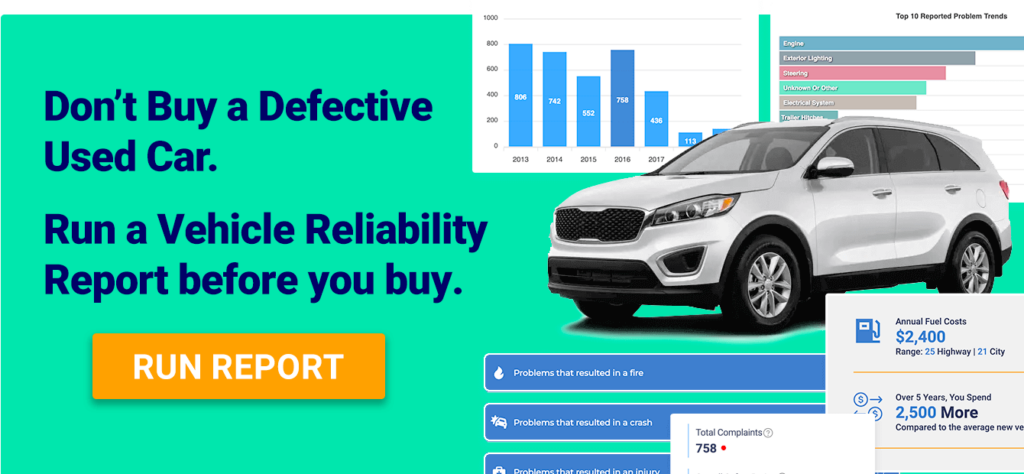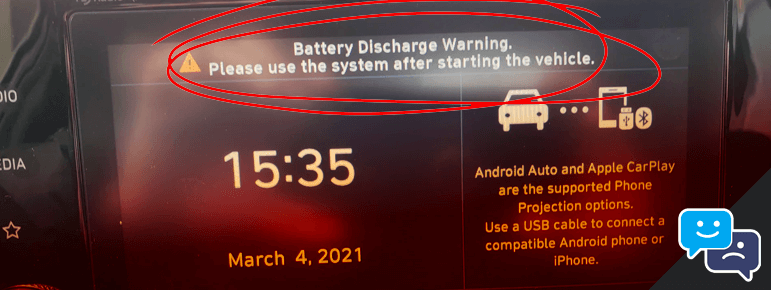Have you ever seen a battery discharge warning light up in your car? This little light is telling you that the car’s battery is losing power faster than it can charge. Cars like Hyundai and Kia have this warning system to let drivers know they need to act fast or they might lose power.
A battery discharge warning indicates your car’s battery is losing charge. It can occur in any vehicle, including Hyundais, Kias, and luxury cars. Common causes include leaving lights on, old batteries, electrical problems, extreme temperatures, and short drives. To fix it, charge the battery, turn off non-essential items, check terminals, and consider professional help for ongoing battery issues.
There are many reasons why this happens, such as leaving lights on, old battery, broken parts in the electrical system, very hot or cold weather, and even just driving short distances.
It’s important to keep your battery from running low because it starts your car and powers things inside when the engine isn’t running. If bad wiring or a weak connection causes trouble, the warning light comes on.
Also, cold below freezing or heat above 167°F hurts how well batteries work too. You can stop this by not using too much electricity when you’re not driving and making sure everything is charged right.
Let’s find out what makes that pesky warning come on and how we can fix it so our cars stay ready for action!
What is a Battery Discharge Warning?
A battery discharge warning is your car’s method of saying “Hey, we’ve got a power issue!” It pops up to alert drivers that the electrical charge within their car’s battery is dwindling and could soon leave them stranded.
Every time this warning pops up on your dash, it’s basically a nudge to check what’s draining your battery before you end up stuck with a car that won’t start. It acts as an early heads-up so you can fix issues before they turn into bigger problems.
Whether you drive a whisper-quiet hybrid model or a trusty Hyundai SUV, when this warning flashes, it’s time for some detective work to pinpoint and address power problems.
Types of Cars that Have this Warning
Now that we know what a battery discharge warning means, let’s look at the kinds of cars that might show this message. This warning is not picky—it can pop up in different brands and models.
Here are some key examples:
- Hyundai cars, especially newer models: Vehicles like the Hyundai Sonata can alert you when your battery might need attention.
- Kia vehicles often have this feature too: If you drive a Kia, keep an eye on your dashboard for important battery messages.
- Luxury brands like BMW: Even high-end cars like those from BMW aren’t immune to battery issues and will warn drivers similarly.
- American-made cars: From Ford to Chevrolet, if your car is modern, it likely includes a system to monitor battery health.
- Electric and hybrid vehicles: These types of cars rely heavily on batteries and typically have advanced systems to watch over battery status.
Causes of a Battery Discharge Warning
That pesky battery discharge warning is a warning your car is losing power fast, alerting you to potential power struggles under the hood.
Let’s dive into what could be causing this automotive cry for help and how you can steer back to full charge.
Leaving lights or accessories on
Leaving lights or accessories on in your car can drain the battery fast. This is a common mistake that many people make. You might forget to turn off the cabin light or leave the headlights on after you park.
Even small things like phone chargers or GPS devices plugged in when your car is off can use up power.
To stop this from happening, always check your lights before leaving the car. Unplug accessories and electronics if you’re not using them.
Make sure everything is turned off so your battery stays charged and ready when you need to start your engine again.
Keep an eye on these simple habits, and you’ll avoid the trouble of a dead battery.

Battery age and wear
Just like anything else, car batteries get old and worn out. Over time, the battery loses its power to hold a charge. This happens because every time you start your car, the battery works hard to power up everything.
After many starts and stops, it doesn’t work as well as it used to.
Old batteries can cause that annoying battery discharge warning light to pop on while you’re driving. To keep this from happening, think about how long you’ve had your current battery.
According to AAA, most last between three to five years. If yours is getting old or seems weak when you try starting your engine, it might be time for a new one.
Next up: let’s talk about what happens when there are problems in your car’s electrical system.
Electrical system malfunctions
Cars have lots of wires and parts that use electricity. Sometimes, these parts can break or get old and not work right. This might make your battery lose power faster than it should.
Imagine you have a leaky faucet at home; if you don’t fix it, the water keeps dripping out. It’s like that with your car’s electric system too—if there’s a problem, power leaks out of the battery!
It’s important to check if things like your radio or lights are working harder than they need to because this can make the battery weak.
If you think something is wrong, get your car to the dealership so they can look for any bad wires or broken parts.
Next up: Extreme temperatures also affect how well your car battery works!
Extreme temperatures
Electrical system issues aren’t the only thing that can trigger a battery discharge warning. Heat and cold are tough on your car’s battery.
When it’s really cold, the battery can’t hold its charge as well, so you might see the warning light come on more often.
The same happens when it heats up past 167°F. That kind of heat messes with the battery life and slows down how fast it can recharge.
To keep your battery happy in hot or cold weather, try to park in a garage if you can. This helps protect it from extreme temperatures.
If there is no garage available, find some shade or use a car cover during hot days to shield your ride from the sun’s harsh rays.
Cold days? A warm spot out of the wind makes all the difference for your car’s battery life!
Battery or charging system issues
Just as extreme temperatures can be tough on your battery, problems with the battery or charging system might also set off that pesky discharge warning. Your car’s battery could be aging or worn out, meaning it doesn’t hold a charge like it used to.
Or maybe the alternator isn’t doing its job right. The alternator is key because it charges the battery while you drive; if it’s broken, your battery will drain fast.
Other times, issues come up with serpentine belts – those long belts in the engine that help run everything smoothly. If they’re damaged or loose, they might not spin the alternator properly and then – zap! No charge for the battery.
To keep everything running well, make sure to check these parts of your car often or get a pro to have a look when you suspect something’s wrong.
Bad ground connection
A bad ground connection is like a weak link in a chain; it can cause lots of trouble for your car’s electrical system. If the ground, which is the return path for electric current, isn’t working right, your battery might not charge well and could send out a discharge warning.
This problem often happens in cars, including brands like Hyundai and Kia. Think of it as trying to drink a milkshake through a straw with holes – you won’t get much milkshake, just like your battery won’t get enough electricity.
Fixing this issue means checking all the connections from your battery to where they hook onto the car’s frame or engine. Sometimes these spots get rusty or dirty and mess up the flow of electricity.
Cleaning them up can really help!
Alternatively, the ground connection to the battery might be loose and simply requires tightening.
This is pretty important because without a good ground connection, you could keep getting that annoying battery discharge warning even if everything else is fine with your car’s power system.
Short driving
Just like a bad ground connection can cause trouble, short drives might be doing your battery no favors either.
Let’s say you drive just a few minutes each day. Your car’s alternator needs time to put power back into the battery, but it doesn’t get enough on these quick trips.
So, what happens? The battery keeps losing charge and never gets fully charged up.
Think about your daily drives to the store or dropping kids at school – they’re probably not long enough for a full recharge. This means over time, your battery is always playing catch-up but never winning the race against discharge.
Keep this in mind next time you wonder why your car might be having trouble starting after lots of short hops around town!
How to Fix a Battery Discharge Warning
Turning off non-essential electrical equipment can save your car’s battery life. This practice prevents unnecessary battery drain when you’re driving or even when the car is idle.
Here’s how you can cut down on power use:
Limit electrical usage
- Identify what counts as non-essential: Think about gadgets like your phone charger, climate control system, and the radio. These don’t need to be on all the time.
- Use the fan instead of air conditioning: Air conditioning uses a lot of power. Try using the fan to cool down your car when possible.
- Unplug devices when not in use: Even if they’re not actively charging, devices plugged into your car can still pull power from the battery.
- Reduce use of headlights and interior lights: Only use them when necessary, such as when it’s dark outside or in poor visibility conditions.
- Turn off seat warmers and steering wheel heaters: These are nice comforts but can drain the battery quickly if left on without thinking.
Check battery terminals
It’s important to check your battery terminals if you get a battery discharge warning. This can fix a faulty ground connection. Here’s how you do it:
- First, turn off your car and wait for the engine to cool down.
- Next, locate the battery under the hood.
- Clean any dirt or rust from the top of the battery with a brush.
- Find the two terminals marked with a plus (+) for positive and a minus ( – ) for negative.
- Wiggle each terminal to see if they’re loose.
- Use a wrench to tighten any loose connections by turning clockwise.
- If there’s corrosion (white or green stuff), mix baking soda with water.
- Dip an old toothbrush in the mixture and scrub off the corrosion.
- Dry everything with a clean cloth after cleaning.
FAQs
1. What does a battery discharge warning mean?
A battery discharge warning lights up when your car’s battery is losing its charge while the engine is running – it’s like a little alert that says, “Hey, something’s not right here!”
2. Why would I see a battery discharge warning in my Hyundai or Kia while driving?
If you’re cruising along in your Hyundai or Kia and this warning pops up, it might be because the battery isn’t getting recharged properly – think of your alternator as a charger that forgot to do its job.
3. Can driving with a discharged battery harm my car?
Yes! Driving with a low-charged battery can leave you stuck since important parts like starters and motors need juice from the battery to kick into action.
4. How do I fix a battery discharge warning?
First off, give that tired-out battery some pep by using a good old-fashioned charger; then check if things like alternators are doing their part right.
5. What should I do if my BMW shows me this scary warning out of nowhere?
Stay calm – start by getting your engine going again if it stopped, but you’ll have to roll into the shop for them to look at what caused your BMW’s unexpected energy slump.
Final Thoughts
To keep your car happy, watch out for that pesky battery discharge warning. If you see the light, think quick and check things out to stop trouble before it starts.
Always remember to conserve energy by turning off unnecessary lights, and be mindful of your battery’s age. Your car will show its appreciation every time you start the engine.

Managing Editor
Christopher is an automotive technical writer. When he’s not at the local autocross event, he can often be found working on one of his cars. Specializes in automotive class action law, industry trends, and automotive maintenance. Email me direct, or learn more about us

